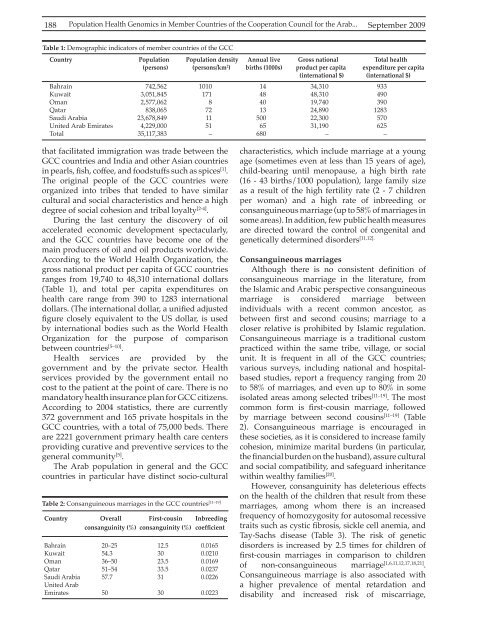Vol 41 # 3 September 2009 - Kma.org.kw
Vol 41 # 3 September 2009 - Kma.org.kw
Vol 41 # 3 September 2009 - Kma.org.kw
You also want an ePaper? Increase the reach of your titles
YUMPU automatically turns print PDFs into web optimized ePapers that Google loves.
188 Population Health Genomics in Member Countries of the Cooperation Council for the Arab...<br />
<strong>September</strong> <strong>2009</strong><br />
Table 1: Demographic indicators of member countries of the GCC<br />
Country Population Population density Annual live Gross national Total health<br />
(persons) (persons/km 2 ) births (1000s) product per capita expenditure per capita<br />
(international $) (international $)<br />
Bahrain 742,562 1010 14 34,310 933<br />
Kuwait 3,051,845 171 48 48,310 490<br />
Oman 2,577,062 8 40 19,740 390<br />
Qatar 838,065 72 13 24,890 1283<br />
Saudi Arabia 23,678,849 11 500 22,300 570<br />
United Arab Emirates 4,229,000 51 65 31,190 625<br />
Total 35,117,383 – 680 – –<br />
that facilitated immigration was trade between the<br />
GCC countries and India and other Asian countries<br />
in pearls, fish, coffee, and foodstuffs such as spices [1] .<br />
The original people of the GCC countries were<br />
<strong>org</strong>anized into tribes that tended to have similar<br />
cultural and social characteristics and hence a high<br />
degree of social cohesion and tribal loyalty [2-4] .<br />
During the last century the discovery of oil<br />
accelerated economic development spectacularly,<br />
and the GCC countries have become one of the<br />
main producers of oil and oil products worldwide.<br />
According to the World Health Organization, the<br />
gross national product per capita of GCC countries<br />
ranges from 19,740 to 48,310 international dollars<br />
(Table 1), and total per capita expenditures on<br />
health care range from 390 to 1283 international<br />
dollars. (The international dollar, a unified adjusted<br />
figure closely equivalent to the US dollar, is used<br />
by international bodies such as the World Health<br />
Organization for the purpose of comparison<br />
between countries [5–10] .<br />
Health services are provided by the<br />
government and by the private sector. Health<br />
services provided by the government entail no<br />
cost to the patient at the point of care. There is no<br />
mandatory health insurance plan for GCC citizens.<br />
According to 2004 statistics, there are currently<br />
372 government and 165 private hospitals in the<br />
GCC countries, with a total of 75,000 beds. There<br />
are 2221 government primary health care centers<br />
providing curative and preventive services to the<br />
general community [5] .<br />
The Arab population in general and the GCC<br />
countries in particular have distinct socio-cultural<br />
Table 2: Consanguineous marriages in the GCC countries [11–19]<br />
Country Overall First-cousin Inbreeding<br />
consanguinity (%) consanguinity (%) coefficient<br />
Bahrain 20–25 12.5 0.0165<br />
Kuwait 54.3 30 0.0210<br />
Oman 36–50 23.5 0.0169<br />
Qatar 51–54 33.5 0.0237<br />
Saudi Arabia 57.7 31 0.0226<br />
United Arab<br />
Emirates 50 30 0.0223<br />
characteristics, which include marriage at a young<br />
age (sometimes even at less than 15 years of age),<br />
child-bearing until menopause, a high birth rate<br />
(16 - 43 births/1000 population), large family size<br />
as a result of the high fertility rate (2 - 7 children<br />
per woman) and a high rate of inbreeding or<br />
consanguineous marriage (up to 58% of marriages in<br />
some areas). In addition, few public health measures<br />
are directed toward the control of congenital and<br />
genetically determined disorders [11,12].<br />
Consanguineous marriages<br />
Although there is no consistent definition of<br />
consanguineous marriage in the literature, from<br />
the Islamic and Arabic perspective consanguineous<br />
marriage is considered marriage between<br />
individuals with a recent common ancestor, as<br />
between first and second cousins; marriage to a<br />
closer relative is prohibited by Islamic regulation.<br />
Consanguineous marriage is a traditional custom<br />
practiced within the same tribe, village, or social<br />
unit. It is frequent in all of the GCC countries;<br />
various surveys, including national and hospitalbased<br />
studies, report a frequency ranging from 20<br />
to 58% of marriages, and even up to 80% in some<br />
isolated areas among selected tribes [11–19] . The most<br />
common form is first-cousin marriage, followed<br />
by marriage between second cousins [11–19] (Table<br />
2). Consanguineous marriage is encouraged in<br />
these societies, as it is considered to increase family<br />
cohesion, minimize marital burdens (in particular,<br />
the financial burden on the husband), assure cultural<br />
and social compatibility, and safeguard inheritance<br />
within wealthy families [20] .<br />
However, consanguinity has deleterious effects<br />
on the health of the children that result from these<br />
marriages, among whom there is an increased<br />
frequency of homozygosity for autosomal recessive<br />
traits such as cystic fibrosis, sickle cell anemia, and<br />
Tay-Sachs disease (Table 3). The risk of genetic<br />
disorders is increased by 2.5 times for children of<br />
first-cousin marriages in comparison to children<br />
of non-consanguineous marriage [1,6,11,12,17,18,21] .<br />
Consanguineous marriage is also associated with<br />
a higher prevalence of mental retardation and<br />
disability and increased risk of miscarriage,
















